All cars, even brand new ones, consume a tiny bit of oil during normal operation. It’s just a natural part of the internal combustion process. Various factors determine just how much oil a vehicle in good working order consumes — driving conditions, engine tolerances, oil viscosity, etc. For example, my 2022 Ural GearUp consumes more oil the faster I drive, and I have to be careful about highway riding because of that. An engine that starts to consume more oil than normal, however, is an engine with one or more serious problems.
There are a number of ways to tell when an engine is consuming a lot of oil, but the most common is blue-white smoke coming from the vehicle’s tailpipe accompanied by the acrid smell of burning oil. This means that excessive oil is making it into the combustion chambers somehow and is being burned up with the normal fuel/air mixture, which is a problem. An engine that burns oil not only pollutes more, but oil getting where it doesn’t belong can contaminate other systems and ruin sensors. The worst case scenario is that it burns so much oil that it runs dry, leading to a catastrophic failure and possibly a hole in the block.
In this article, we’ll take a look at some reasons why a car might burn oil and what to do about them.
What should I look for?
The most common reason that an engine burns oil is that the piston rings have gone bad. Piston rings are thin metal seals clipped into grooves around the top of an engine’s pistons that form a barrier between the pistons and cylinder walls. They keep oil out and pressure in the engine’s combustion chamber, but when they go bad, they allow excess oil into the combustion chamber (and reduce an engine’s compression). Because they operate in an extremely hostile environment, piston rings take a lot of abuse. An old or high-mileage engine often smokes and burns oil because the piston rings are heavily worn, stuck, or even broken.
Bad valve seals are another way oil can get into an engine’s combustion chamber. Valves need oil to keep them lubricated, and the valve seal keeps that oil in the top end where it belongs. Like piston rings, valve seals are a wear item and an engine with a lot of miles may develop leaky valve seals. Other reasons a car might burn oil include a blown head gasket, overheating or over-revving, or even the wrong oil type. If you use an oil that’s too thin or slippery, the oil can simply seep past the rings and into the combustion chamber.
One overlooked but relatively common reason a car might burn some oil is a clogged or compromised Positive Crankcase Ventilation system. If your vehicle’s PCV valve gets stopped up or otherwise fails, it can cause an overpressure situation inside the engine. This excess pressure can push more oil than usual past the engine’s seals and into the combustion chambers, making the engine smoke.
What do I do now?
Look, I’m gonna level with you. If your vehicle is burning oil and smoking real bad you have two choices — take it to the shop and have it fixed or junk it. Well, there is the third option of ignoring the problem, driving the vehicle as-is, and having a case of oil in your back seat, but that’s basically just the “junk it” option stretched out over a longer timeframe.
An engine that burns oil is inefficient, pollutes more, and is on borrowed time. You might try some of that good automotive snake oil you find down at the local auto parts store, but that’s a temporary fix at best. However, you’ll have to do your own cost/benefit analysis to see whether fixing the problem or replacing the whole vehicle is the better option, but if you don’t make that decision relatively quickly the engine will make it for you.





